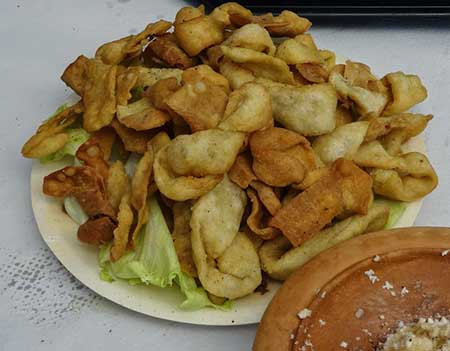Recipe for
Catillus Ornatus
(Spiced fritters)

by Athenaeus The Partying Professors

Roman Cookery: Ancient Recipes for Modern Kitchens.
Yes, this book has a new cover, but I like this one better. Blah, I am so horrible.
This is another ancestor of pasta, a modern descendant called uruq khass which hails from Iraq and consists of lettuce, onions, parsley, flour, eggs, cumin and pepper — it makes an excellent accompaniment to vegetable purees.
Original recipe:
Translation: What the Romans call catillus ornatus is made like this: wash and mash some lettuce, pour wine into a mortar and puree the lettuce. Then squeeze off the juice, knead fine wheat flour into it, let it rest for a while, than pound it vigorously. Add a little porkfilt and pepper, pound it once again, draw it out thinly, cut it into pieces, put the pieces into a strainer and fry in the hottest olive oil.
Ingredients
- 1 lettuce
- 150 ml/5floz red wine
- 30g/l oz lard or vegetable fat
- 300 g/10 oz spelt flour
- Black pepper
- olive oil for frying
Preparation
- Mash the lettuce in a blender with the red wine and vegetable fat.
- When the lettuce is mainly juice, add the spelt flour and continue to blend until a soft dough has been made.
- Season with plenty of black pepper.
- Working on board sprinkled with flour, flatten the dough until it is as thin as possible. If possible, try not to use a rolling pin as this can lead to holes in the dough.
- Dust the top of the dough with flour. Then using a pastry cutter, cut out the fritters.
- Heat three tablespoons of olive oil in a frying pan and fry the fritters, turning often so they are evenly brown on both sides. Drain the fritters on kitchen paper when cooked.
- Grind a black pepper over the fritters before serving.




















